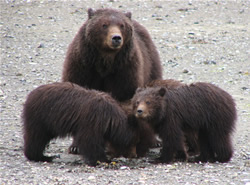Pack Creek Brown Bear Viewing Area
 |
The native Tlingít people call Admiralty Island "Kootznoowoo," or "Fortress of the Bears." The island is home to an estimated 1,500 brown bears -- more than all the Lower 48 states combined.
At the Pack Creek Brown Bear Viewing Area, you can enter the bears' world and watch these magnificent creatures in their natural setting.
A 30-minute floatplane ride from Juneau, or 40 miles, Pack Creek, located in the northeast corner of Admiralty Island, is popular with locals and visitors alike.
As you plan your trip it is important to keep in mind the following information:
- The Pack Creek Bear Viewing Area is a Wilderness Area. This means there are no facilities on site, including no bathrooms, no shelter from the elements (except at the Observation Tower) and no cell phone service.
- Access to and traveling around the bear viewing area requires getting your feet wet, so make sure you have rubber boots.
- Bring rain gear and extra layers, even if the weather seems to be nice. The weather can turn cold and rainy at any time of the year in southeast Alaska.
- Lastly, no bears or people have been harmed at Pack Creek since the area has been actively managed. In order to maintain this record all visitors must strictly follow the rules outlined by the rangers. This will ensure a safe and stress free environment for the bears that make their home at Pack Creek.
To protect the bears and other wilderness resources at Pack Creek, a permit is required to visit Pack Creek between June 1 and September 10. Fees, and Changes and Cancellations Policy for Pack Creek.
Pack Creek has been a popular bear viewing destination since at least the 1930s. Today the area is cooperatively managed by the USDA Forest Service and the Alaska Dept. of Fish & Game, whose staff are available to provide orientations and answer questions during your visit.
What to expect
What to expect
When you arrive at Pack Creek you will be greeted by a ranger at the South Spit. You will disembark your float plane or boat in 8-12 inches of water, so rubber boots are recommended. After an orientation given by the ranger you will either walk to the Viewing Spit or to the Observation Tower. The ranger will provide advice on the likelihood of seeing bears at both of these areas, but you will be free to decide where you want to go. The ranger will also review all of the rules to be followed while visiting Pack Creek - these include no food in any area other than the South Pit, staying together as a group when traveling, staying on the designated travel routes only, never leaving gear or personal belongings unattended and following any other directions provided by the rangers.
Keep in mind that Pack Creek is part of the Kootznoowoo Wilderness. Wilderness visitors face inherent risks of adverse weather conditions, isolation, physical hazards and lack of rapid communications. Please take a few minutes to think about and understand these risks.
The Bears
The Bears
The Tongass National Forest is home to both black bears (ursus americanus) and brown bears (ursos arctos). However, Admiralty Island is inhabited exclusively by brown bears.
Brown bears (akin to "grizzlies" in the interior) are easily distinguished by a large hump of muscle over their shoulders, as well as a dish-shaped face.
Color is not a reliable way to determine species, as bears come in countless shades of brown, blonde, black and even cinnamon.
A typical bear's year begins in the spring when it emerges from hibernation. Adult males are the first to leave their den, sometimes as early as March. Females with cubs spend the most time hibernating, with some not leaving until May.
A History of Bear Viewing
A History of Bear Viewing
Bear viewing at Pack Creek dates back to at least the 1930s, when the area became popular with visitors from Juneau. In 1934 the Territorial Game Commission prohibited bear hunting within 20 square miles around Pack Creek. One year later, the Civilian Conservation Corps built a trail and a small tree stand overlooking Pack Creek (this stand was replaced with the current tower in 1990).
The Alaska Board of Game expanded the hunting closure in 1984 to include Swan Cove, Swan Island and Windfall Harbor -- a total of about 95 square miles.
This is one of the few areas of Admiralty that is closed to bear hunting; more than 95% of the island remains open.
The 60,800-acre Stan Price State Wildlife Sanctuary was created in 1990, and includes the Pack Creek drainage and the mud flats at the mouth of Pack Creek.
The Nature of Pack Creek
The Nature of Pack Creek
From its headwaters 4000 feet above sea level, Pack Creek descends rapidly to the salt water of upper Seymour Canal. Sediment picked up by the creek is deposited at its mouth, creating a 400-acre mud flat. These flats are an important source of food for many animals, including bears, which feed on clams, shellfish and other creatures.
Of course, the main reason bears are drawn to Pack Creek is salmon. Pack Creek supports healthy runs of pink and chum salmon, which return to spawn in their natal stream. Peak bear viewing usually follows the return of salmon to Pack Creek, usually the first week on July.
The Pack Creek ecosystem is home to more than just brown bears; Admiralty Island contains the highest concentration of bald eagles in the world, and Sitka black-tail deer thrive in the rich sedge meadows and in the old-growth forest. Mink, marten, and otter are common along the islands shores, as are nearly countless varieties of birds.


